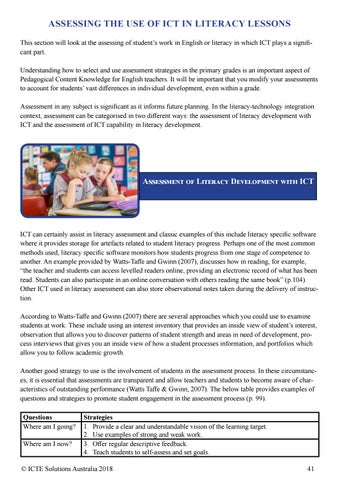ASSESSING THE USE OF ICT IN LITERACY LESSONS This section will look at the assessing of student’s work in English or literacy in which ICT plays a significant part. Understanding how to select and use assessment strategies in the primary grades is an important aspect of Pedagogical Content Knowledge for English teachers. It will be important that you modify your assessments to account for students’ vast differences in individual development, even within a grade. Assessment in any subject is significant as it informs future planning. In the literacy-technology integration context, assessment can be categorised in two different ways: the assessment of literacy development with ICT and the assessment of ICT capability in literacy development.
Assessment of Literacy Development with ICT
ICT can certainly assist in literacy assessment and classic examples of this include literacy specific software where it provides storage for artefacts related to student literacy progress. Perhaps one of the most common methods used, literacy specific software monitors how students progress from one stage of competence to another. An example provided by Watts-Taffe and Gwinn (2007), discusses how in reading, for example, “the teacher and students can access levelled readers online, providing an electronic record of what has been read. Students can also participate in an online conversation with others reading the same book” (p.104). Other ICT used in literacy assessment can also store observational notes taken during the delivery of instruction. According to Watts-Taffe and Gwinn (2007) there are several approaches which you could use to examine students at work. These include using an interest inventory that provides an inside view of student’s interest, observation that allows you to discover patterns of student strength and areas in need of development, process interviews that gives you an inside view of how a student processes information, and portfolios which allow you to follow academic growth. Another good strategy to use is the involvement of students in the assessment process. In these circumstances, it is essential that assessments are transparent and allow teachers and students to become aware of characteristics of outstanding performance (Watts Taffe & Gwinn, 2007). The below table provides examples of questions and strategies to promote student engagement in the assessment process (p. 99). Questions Where am I going? Where am I now?
Strategies 1. Provide a clear and understandable vision of the learning target. 2. Use examples of strong and weak work. 3. Offer regular descriptive feedback. 4. Teach students to self-assess and set goals.
© ICTE Solutions Australia 2018
41






